by Marion Patterson | Aug 26, 2021 | (Sub)Urban Homesteading, Flowers/Grasses, Garden/Yard, Labyrinths
In early July we sat on our front porch watching delightfully splashes of color dance in the breeze. A restoration triumph stood stoutly in the wind-blooming compass plant.
Restoring prairies takes patience. We began ten years ago by converting a former mowed lawn into a prairie. For the next few years, our emerging prairie looked rough. A weed patch mostly, but as the years rolled by the “weeds” also called Mother Nature’s stitches, retreated as prairie plants matured and outcompeted them. Coreopsis, coneflowers, monarda, and vervain began adding color to ever more vigorous big and little bluestem, switch, and Indian Grasses.
Then, this year, compass plants that had been flowerless for years, shot spikes six feet into the air. In mid-July, the plant is in full bloom.
Difference Between Domestic and Native Plants
When you plant beans, tomatoes, or squash and many domestic flowers and the fruits of labor are rewarded that same year with fresh vegetables and colorful petals. Not so with native plants. Prairie takes patience. Some native pioneers come on in a year or two but many wait and wait and wait. Sometimes it can take upwards of 15 years for stately compass plants to bloom, so ours may be racehorses to show color in just a decade. More point skyward along with coneflowers, purple prairie coneflower, and rattlesnake master along the roadside in front of our yard.
We have tour prairies at Winding Pathways. Into our oldest Marion has crafted a prairie labyrinth, giving walkers an opportunity to follow a contemplative path surrounded by blooming, dancing flowers and tall grasses.
The “middle-aged” prairie out in the back is a haven for birds, adds color, and is a buffer from the ruined-looking woods where young trees are starting to show amidst the broken derecho tree trunks.
In 2019 and following the August 10th, 2020, Derecho we scattered prairie/open woodland seeds to encourage diverse plants on the east-facing slope.
Our youngest prairie, planted in the spring of 2020, remains in infancy. A mass of black-eyed Susans shines brightly, and many other small bloomless plants show promise to color up as the years go by. We look forward to their future.
We welcome anyone to visit, walk the labyrinth, and enjoy our prairie and the butterflies that skip from flower to flower within it.
-
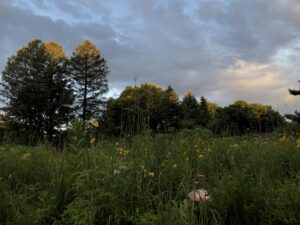
-
Sun rising over the prairie.
-
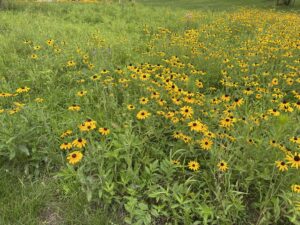
-
Pioneer plants like the Black Eyed Susans encourage people as they plant prairies.
-
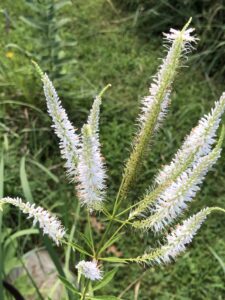
-
The demure, white spikes of Culver’s Root attract pollinators.
-
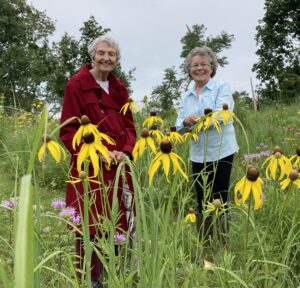
-
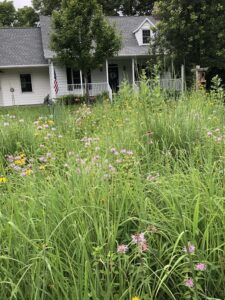
-
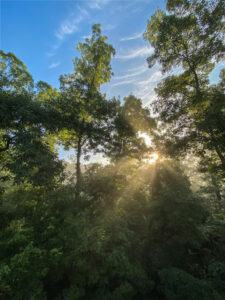
-
Morning sunlight.
by Winding Pathways | May 6, 2021 | (Sub)Urban Homesteading, Flowers/Grasses, Garden/Yard
Springtime on the Prairie
This spring we anxiously await the emergence of prairie flowers in an area that had been traditional lawn. This is a periodic continuing blog about the process of converting the lawn to a prairie. We’ll have a couple more updates this season. Here’s what we did to prepare for this year’s growth:
2020
April and May 2020: Sustainable Landscape Solutions sprayed the lawn twice to kill existing grass plants, which were nearly entirely exotic species.
May 2020: Sustainable Landscape Solutions tilled the now dead turf.
May 2020: Rich and Marion broadcast a diverse array of seeds that included 82 wildflower species and a few lower-growing types of priaire grasses.
August 2020: A derecho felled three trees west of the site and a few to the east. This increases the sun on the new prairie. That’s good.
By mid-summer, a thick growth of annual crabgrass covered the site with only partridge pea obvious from our seeds.
November 2020: The crabgrass was dead and dry, so we burned it on the same day we burned our existing prairies. The fire was slow and low.
2021
Winter 2020/21: Heavy snow covered the site for much of the winter. When it melted, we discovered mostly bare soil with few surviving exotic grasses present. This is perfect, as native seeds will respond to warm temperatures.
April 2021: Small prairie forbs are emerging. Among the many spring greens poking up, we can identify Black-Eyed Susans, Mountain Mint, and Partridge Pea. Only a few of the 82 species we cast out. Part of the fun of restoring prairie is learning what the emerging plants are.
-
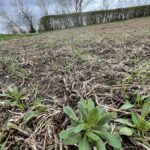
-
Part of the fun of establishing prairies is learning what the plants are.
-
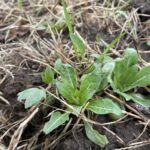
-
Possibly shooting star?
-
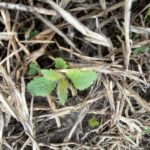
-
Poking through
We’ll update with a Prairie Renaissance Blog as the natives get going.
by Winding Pathways | Aug 6, 2020 | (Sub)Urban Homesteading, Flowers/Grasses, Garden/Yard, Garden/Yard
Learning from the Prairie
Wow. It’s August! We recently completed a management step on the prairie planted in early June. Weeds were outgrowing infant prairie plants that need sunshine. We buzzed off the weeds at the highest setting possible on our battery-powered cordless EGO mower.
We bought this mower because its battery powers a powerful electric mower that easily cuts tough grass while producing less emissions than a gas mower. And, it’s easy to use. No cord pulling to start it. Also, the mow height is simple to set and allows us a high setting that helps with prairie management.
-
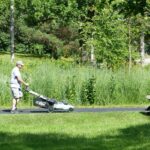
-
The mower and wheelbarrow.
-
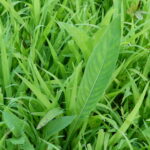
-
Prairie plants among grass.
-
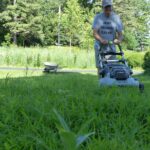
-
Emerging prairie plants will get more sunlight when the competing grasses are mowed off
Afternoon Delight
We planted a prairie in front of the house nine years ago and now spend hours sitting on the front porch reading and talking but always watching the prairie. Here are observations that make us delighted we converted a lawn to the prairie:
- Stunning beauty. We enjoy a changing array of colorful flowers and grasses that dance in the breeze. Coneflowers have been in bloom for a while. Milkweed blooms have faded. And, cupplants are just now coming into their midsummer glory.
- Insects. Monarchs and swallowtails cavort over the prairie on sunny days while stopping to sip nectar. Each evening the air over our prairie swarms with delightful lightning bugs. They are absent over the nearby lawn.
- Wrens, bluebirds, and goldfinches. A pair of wrens nested in a box just above our porch chairs. We love watching these industrious parents make trip after trip foraging for insects to feed the youngsters. They hunt in the prairie and nearby woods edge but not in the lawn. Our prairie enables our yard to support at least four pairs of nesting wrens and one pair of bluebirds. If the entire yard were mowed, we’d be lucky to have one wren couple to enjoy. In mid-summer goldfinches work the prairie.
- Garter and brown snakes. We’ve noticed an increase in garter and brown snakes, both harmless species as beautiful and interesting as goldfinches or cardinals.
-
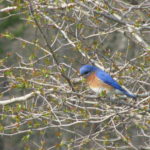
-
Bluebirds hang out on branches.
-
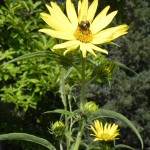
-
This hardy late season bloomer is vital for pollinators and migratory birds.
-
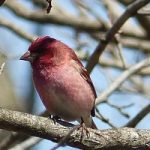
-
Some birds homestead at Winding Pathways.
Phoenix Harmony Labyrinth Prairie
Marion crafted a labyrinth through our oldest prairie on the front yard. She welcomes anyone to walk its circular path. Contact us before you come. The labyrinth is a peaceful way to access the prairie and contemplate the beauty of our earth while walking along its path.
-
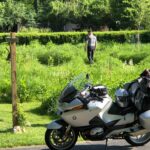
-
People call and stop by to walk.
-
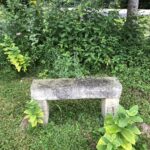
-
Visitors can rest and watch the prairie labyrinth.
-
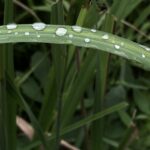
-
Prairie plants capture dew.
-
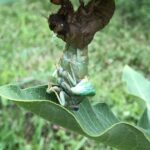
-
A rare treat is watching insect life emerge from one stage to another.
-
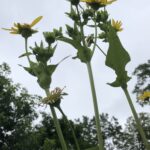
-
Cupplants hold water near their stem. Birds and insects sip
-
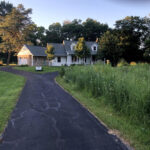
Make Like a Buffalo
When Sustainable Landscape Solutions did ground preparation for our new prairie, I asked Sean Pearl if he’d create two “artificial gopher mounds” in an older prairie in our backyard. He said “Sure.” A while back, we had planted this prairie with just grass seed. It has few flowers, and the roots of the big bluestem, Indiangrass, and switchgrass are tough and dense. Prairie needs disturbance. Once bison wallowed and gophers dug to create bare earth. Many prairie grasses need this bare earth to reseed. We had neither bison nor gophers so used a machine to create bare soil.
Sean’s machine chopped through the grasses. We followed up by planting 82 flower species seeds. Flowers add diversity, color, and attract pollinating insects. Looks like it’s working. Lots of new prairie wildflowers are growing in these two places in the midst of towering grasses.
Our next Prairie Renaissance blog will come in early fall.
by Winding Pathways | May 15, 2020 | (Sub)Urban Homesteading, Flowers/Grasses, Garden/Yard, Garden/Yard
Moving Forward
Once we made the decision to convert about 3,000 square feet of our lawn to a prairie, we began active planning. We have 40 years of prairie establishment and management experience so it was easy for us, but we still needed help and sought partners.
We contacted many organizations and found support for our project from these people and groups:
Sustainable Landscape Solutions, a business based in Iowa City. We hired them to do ground preparation. Sean Pearl is the owner.
Monarch Research Project, an active Cedar Rapids-based group that encourages pollinator plantings.
Linn County Secondary Roads. Since our prairie is near a Linn County road we wanted their support.
Pheasants Forever. We received help from a biologist, Allie Rath, and bought an outstanding seed mix from Pheasants Forever. Matt O’Connor manages the seed store and encouraged us to buy a Leopold Mix that contains about 72 species of flowers. Our seeds were produced at the Allendan Seed Company in southern Iowa.
Good Neighbor Iowa. This organization encourages people to shun lawn chemicals and plant native vegetation. A key contact is Audrey Tranlam.
Requirements
We wanted the prairie to be diverse in plant species, establish as rapidly as possible, and be “short profile”. Meaning we did not plant tall big bluestem, Indian grass, and Switchgrass.
We chose the Leopold mix because it has a diversity of flowering plants. And, Pheasants Forever kindly removed the tall-growing grasses from the mix for us.
Preparing and Seeding
Years ago when we began restoring prairies at Indian Creek Nature Center, it was impossible to buy seed, and little was known about how to establish a healthy native grassland. The Center had no money to invest in planting. Jock Ingels was a savvy restorationist based in Illinois. He gave us this advice, “If you don’t have any money but want a prairie, go pick some seeds and broadcast them into the existing lawn. Then burn it. Then wait. You’ll think you wasted your time because nothing will show after a year or even two years but burn it annually. By the third year, you’ll see prairie plants appear and it will get better each year after.” He was right. We gathered seed, planted at the Indian Creek Nature Center, and burned it annually.
At the Nature Center, we got a prairie at no cost and avoided herbicides and ground preparation but it had a limited diversity of species. The newly established prairie was far healthier ecologically than the bromegrass that was once there. For the prairie we wanted to establish at our home, we wanted a more diverse prairie and more quickly. So, we chose a faster method. Mind you, we are not keen on sprays but recognize they have a place.
Sustainable Landscape Staff sprayed our lawn with roundup in late April to kill the grass. They returned one week later and resprayed it to kill the remaining grass.
-
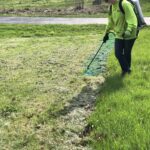
-
Caitlin carefully applies spray.
-
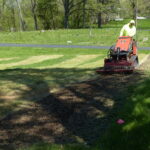
-
Tilling up the lawn.
-
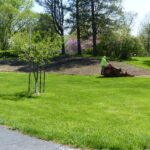
-
Finishing the edge.
-
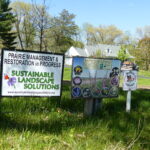
-
Three cooperators’ signs.
They returned a week later and rototilled the area to expose the soil. Spraying and tilling allows newly planted native seeds to grow with less competition from exotic lawn species. It emerges as a more diverse prairie faster than if spraying and tilling are avoided.
In the next installment of this series, we’ll show photos of us seeding the prairie and explain various other ways of establishing a prairie or pollinator meadow. But because lawns are now growing and people are mowing we’ll leave with this thought:
There’s a no-cost method of diversifying a lawn that reduces work. Simply mark off a section of the lawn and don’t mow it. It can be small. Many native plants have durable seeds that remain dormant in the soil for years or decades. They can’t succeed with constant mowing, so to increase plant diversity simply stop mowing a section of lawn and try to identify the new plants that emerge. You will help pollinators.
There’s a new phone app that we’re using to help identify plants we’re not familiar with. It’s called SEEK and is produced by the National Geographic Society, the California Academy of Science, and other groups. It’s free and can be accessed from the app store. You point the phone at a plant, insect, bird, or even a fungus, click a photo, and SEEK will identify it for you. It’s mostly accurate.
by Winding Pathways | Aug 29, 2019 | Birds, Bugs, Flowers/Grasses, Garden/Yard, Nature
On a sunny, warm, late summer day we watched countless bees and butterflies foraging on prairie plants, hummingbirds sipping nectar from Cardinal flowers, and small birds pausing to drink water on the cup plants. That evening, bats swooped across the sky as clouds gathered. Then, came the downpour.
So, we wondered, where do birds and bees and bats go during storms or just to rest? A bit of Internet searching yielded some fascinating information.
Bees
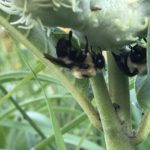
seeking shelter from the rain
Bees are active in the day and need sleep just like humans do. How they sleep is quite different. Bees and many insects do not have eyelids. They relax the body and antennae and sometimes fall over. Sometimes, the other bees in a honeybee colony prop up the “sleeping” bee. As we see in this video, and similar to human babies, they sleep in shorter bursts. This sleep helps their memory. Remember, bees, especially honeybees explore new foraging spots, return to the hive, communicate through a “dance” telling other bees where the source of nectar is. As with people, good sleep helps them perform better. Look for bees on the underside of leaves and grass blades after a rain or in the early morning.
Butterflies
Butterflies also seek shelter on the underside of leaves or grass blades. This vegetation protects them from furious winds and debilitating raindrops. Think about it! How delicate a butterfly’s wings are and how a large raindrop can punish it. A Scientific American article gave a great comparison to us humans – being whacked by a water balloon twice the mass of a bowling ball!
Birds and Bats
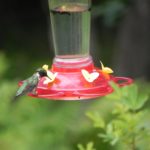
One hummingbird fell into a torpor on the feeder!
To rest, Hummingbirds go into torpor – a sleep-like state where the body temperature drops to conserve energy. They sometimes hang upside down as we see in this video. When the temperatures rise, they “wake up”. They can fly in moderate rains.
Some larger birds, like turkeys, actually come out in rainstorms and forage on insects that are slowed down by the cooler temperatures. At night, turkeys roost in trees. Watching them navigate through dense forests into the tops of sturdy trees is amazing.
Nighthawks, along with their nocturnal companions bats, find daytime shelter on tree branches. Bats tuck under tree bark flaps, in crevices and caves, and enter tiny cracks in homes making attics a cozy den.
Next time you are out and about, look carefully on undersides of leaves and grass blades, study branches of trees for unusual shapes that might be a roosting bird, and notice animals out and about at different times of the day and in different weather.
by Winding Pathways | Jun 6, 2019 | (Sub)Urban Homesteading, Flowers/Grasses, Garden/Yard, Garden/Yard
Weeds Brighten Our Lawn
Too many people worry about lawn weeds and spend money to buy and spray toxic chemicals. We take a different view. What many call weeds are actually beneficial and we find fascinating. The often-uninvited plants that diversify our lawn connect us with human history, teach us botany, sometimes provide nutrition, and add color to our yard.
We don’t spray or fertilize our lawns at Winding Pathways. The mower gets exercise when grass gets shaggy, but we’re never bothered when new plants show up. Instead, we try to identify them and sometimes mow around them to let them bloom and add color to Winding Pathways.
Here are three “weeds” that we are enjoying this summer for their color:
Hawkweed
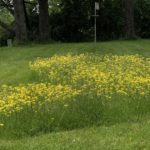
Hawkweed is “asexual”.
In mid-spring, a small patch of tiny hawkweed plants was poking through our grass. Rich mowed around them and by late May we enjoyed watching bright yellow hawkweed blooms dance in the sunny breeze.
There are many species of hawkweed. Most are exotic but some are native. Most sport yellow flowers although some can be reddish. Farmers sometimes consider them a weed. Perhaps the most interesting thing about them is their unusual reproduction. They usually spread by seed, but hawkweed seeds aren’t fertilized, meaning that the seed is an exact genetic clone of its parent. They’re asexual!
We’ll enjoy our Hawkweed until their blooms fade and then likely will mow the patch.
Star of Bethlehem
One of our favorite early spring wildflowers is the impressive but delicate bloom of the native Bloodroot. Its pure white petals are showy against the late March or early April ground. A common early summer lawn weed that has a bloodroot-looking flower is the Star of Bethlehem. It’s a lily that is sometimes sold in nurseries. The plant is not native and shows up in our lawn, probably the result of a previous owner planting bulbs years ago. Star of Bethlehem can be invasive, so we enjoy its showy bloom but mow it off before it has a chance to seed. The plant is a perennial and comes up from bulbs each year, so mowing won’t eliminate it but may keep it from seeding.
-
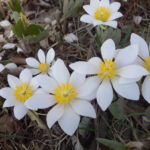
-
Bloodroot is an early spring bloomer. Photo credit Susan Hrobar
-
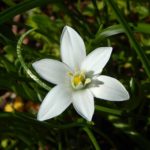
-
Star of Bethlehem.Six-petaled flower. Pixabay photo
Shepherd’s Purse
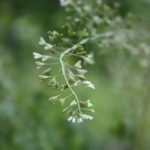
Shepherd’s Purse. From Pixabay
An intriguing plant that grows more on the side of the lawn than in the middle is Shepherd’s Purse. Its name comes from the triangular flat fruits that look like a tiny purse. Native to Europe and Asia Minor it may now be the second most common weed worldwide. Shepherd’s Purse has medicinal and food value and may have been deliberately spread by people.
Nature loves diversity. A function of invasive plants is their very nature. Spray a lawn and kill every plant species other than Kentucky Bluegrass and soon “weeds” will move right in. Diversity creates a certain degree of ecological stability, but there’s always change. A fascination of tending a natural unpoisoned lawn is learning to identify new species as they arrive by themselves and watching plant transitions over the years. A common uninvited plant one year may totally disappear the next to be replaced by some new species. Observing is just plain fun that can never be enjoyed by the person who poisons fascinating lawn plants.































